Frederic Church, Winslow Homer and Thomas Moran: Tourism and the American Landscape
Cooper-Hewitt National Design Museum, New York
19 May-22 October 2006
Cindi Di Marzo
The Smithsonian Institution's National Design Museum, the Cooper-Hewitt, located in New York City, has placed a spotlight on Frederic Church (1826-1900), Winslow Homer (1836-1910) and Thomas Moran (1837-1926), whose names and works became known throughout the land via a variety of printed materials and decorative objects, all aimed at introducing the rest of the country to America's scenic treasures.
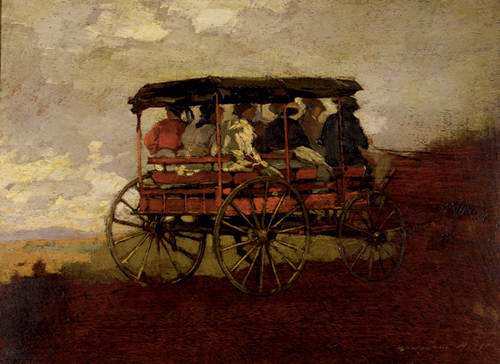
Winslow Homer (American, 1836-1910), White Mountain Wagon. U.S.A., 1869. Brush and oil paint on wood panel. Gift of Mrs. Charles Savage Homer, Jr., 1918-20-9. Photo: Matt Flynn
Beyond the array of beautiful landscapes and character studies - oils, watercolours, etchings and drawings - 'Frederic Church, Winslow Homer and Thomas Moran: Tourism and the American Landscape' delves into the roots of the American tourist industry, with its aggressive marketing campaigns and reach into nearly every aspect of daily life. Images created by Church, Homer and Moran were reproduced in newspapers, popular magazines and books; on trade cards and printed dinnerware; and as lithographs and stereoviews. Through the medium of the stereoview, which presents a three-dimensional image, people gained a vicarious experience of 'being there'.1 With stereographs and lithographs, the two primary means of mass distribution of visual images, people of modest means could display in their own homes pictures of places that were quickly becoming symbols of cherished American values.
The exhibit presents the Cooper-Hewitt's American landscape collection for the first time in more than 15 years and is the first showing of many oils by Homer among its holdings. The show unfolds by region and includes a room-size stereoscope, and copies of early black and white films taken by Thomas Edison; a room devoted to the national parks movement in America; and a recreated 19th-century parlour located in the museum's 'teak room'. Designed by Lockwood de Forest, a contemporary of Homer and Moran, the 'teak room' contains Native American-inspired woodwork and stencilled patterning.
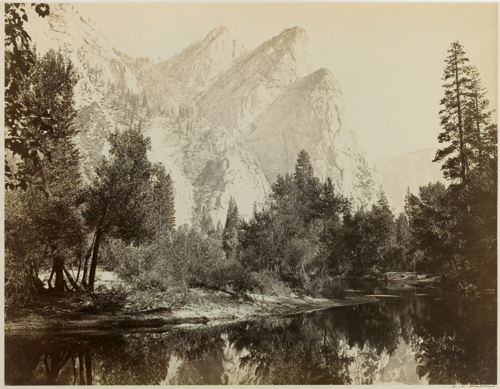
Carleton E. Watkins (American, 1829-1916), Three Brothers, Yosemite. U.S.A., ca. 1861. Albumen print. 1976-23-13
With the creation of a new leisure class with more money and free time, people were transformed from armchair travellers to eager vacationers. Before 1860, an estimated 75,000 people took annual summer vacations. By 1900, the figure had grown to three million. After the Civil War, business and family travel increased rapidly. As in England, when industrial and urban development began to have negative impacts on the environment and traditional lifestyles, people longed for untouched areas, which, in their imaginations, were free of the problems that accompanied industrial growth. The idealistic images offered by Church, Homer and Moran paralleled their own visions of the peace, health and happiness to be found in the wild. Meanwhile, real estate developers and advertising professionals saw a golden opportunity in Niagara, the Adirondacks, New Hampshire, Maine, the Grand Canyon and Yosemite.
The Adirondacks were virtually untapped until after the Civil War. Part of James Fenimore Cooper's The Last of the Mohicans (1826) is set in the Adirondacks, and sportsmen were already being drawn to the area. But what was known popularly of the area came from William HH Murray's bestseller, Adventures in the Wilderness; or Camp-Life in the Adirondacks (1869). Following the book's publication, the Adirondacks experienced an influx of vacationers who benefited from the concurrent construction of hotels and establishment of stage-coach lines. Railroad developer, TC Durant, who had helped to build the Union Pacific Railroad, completed the Adirondack Railroad, connecting fashionable Saratoga Springs with the Adirondacks and other rail lines brought tourists to the Adirondacks from Albany and Plattsburgh.
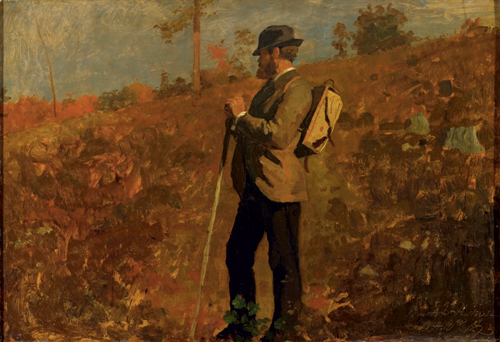
Winslow Homer (American, 1836-1910), Man with a Knapsack. U.S.A., 1873. Brush and oil paint on canvas. Gift of Mrs. Charles Savage Homer, Jr., 1918-20-1. Photo: Matt Flynn
From summer bungalows to grand hotels with hundreds of rooms, real estate developers catered to travellers of all types. Campsites and lodges drew families, while cottages in small communities drew artists. Private clubs were built for sportsmen; Homer, a fisherman and avid outdoorsman, travelled each year from his Maine home to the North Woods Club in the Adirondacks. The few hotels that had existed prior to the Civil War were renovated to attract more business. For example, Catskill Mountain House, built in 1823 on a mountain cliff overlooking the Hudson River Valley, was expanded 20 years later from 50 rooms to 400. The owner of the house, Charles L Beach, whose business interests included stage coach and steamboat lines, recruited popular writers - including Washington Irving, James Fenimore Cooper and William Cullen Bryant - to contribute essays for a promotional pamphet. Beach's well-calculated publicity campaign attracted a sophisticated clientele of wealthy Europeans, politicians and artists. In 1882, Beach opened the Catskill Mountain Railroad, running from Catskill Point to Palenville.
The artists selected for this exhibit were able promoters of American travel through their masterful works and their own passionate connections to nature. Associated today with the Hudson River School, Frederic Church was a world traveller who pursued his interests with an admirable tenacity. He travelled to Ecuador and Colombia in 1853, and again in 1857; Labrador in 1859; Jamaica in 1865; and Europe, including Italy, Greece, Palestine and Syria, in 1868. When he returned, he built his beautiful home, Olana, on a mountaintop overlooking the Hudson River and the Catskill Mountains. He filled Olana with his own works and those by artists he admired and decorated it with eclectic Moorish accents. During this time, Church explored his own country's beauty and created numerous works that capture the area surrounding Olana at various times of the day and in different seasons.
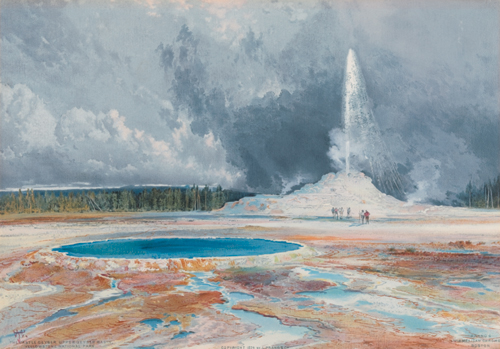
After Thomas Moran (American, 1837-1926), Castle Geyser, Upper Geyser Basin, Yellowstone. U.S.A., published 1874. Chromolithograph on white wove paper. Museum purchase through gift of Louis R. Ehrich, 1941-9-1. Photo: Matt Flynn
His glorious, small-scale explosions of colour and emotion, in particular, are evidence that the views he encountered in America had sent his soul soaring. In 'Niagara from Goat Island, Winter, March 1856' (brush and oil paint, traces of graphite on board), snow in the foreground gives way to brown and putty tones midway as startling peach billows float downward over the agitated waters. Standing before this intimate yet powerful piece, viewers might feel the frosty air on their faces, hear the water rush and roar and marvel at the fiery accents that make luminous an otherwise menacing landscape. In his first major painting of the falls, 'Niagara' (1857), Church chose to portray the falls without a landmass between viewers and the water. His composition is the first to effectively bring viewers into the scene and make them feel as if they are in the midst of the swirling waters. Church captured many views of the Hudson Valley from Olana. Such scenes as 'Sunset across the Hudson Valley, Winter, 1870-80,' reveal the artist's profound appreciation of the interplay of light, shadow and shifting colours offered each night near his home.
In 1850, inspired by Henry David Thoreau's 1846 account of a climb to Mount Katahdin, Church took a steamboat to Mount Desert Island, Maine. Due in large part to Church's depictions and those of his teacher, Thomas Cole, Maine's more accessible areas became magnets for summer vacationers. The influx of 'outsiders' alarmed local homeowners; Acadia National Park, the only national park in the eastern US, was created in response to their call for land protection. Support for the park can also be credited to Church and Cole, who gave the rest of the country a glimpse of Maine's pristine beauty and sparked a desire to preserve it.
Born in Hartford, Connecticut, Church chose art as his vocation when he was quite young. After studying for a time with Benjamin Coe, Church moved to Catskill, New York, to study with Cole, a prominent artist in the Hudson River School. When Cole died four years later, he had already made his mark on Church, whose work is now considered to be the culmination of the Hudson River tradition. Although Church's work is grounded in representational technique, his explosive sunsets might well be described as Expressionistic. This much sought-after artist's work appealed to a large audience, a fact noted by promoters of tourism. Their patronage helped to make Church one of the most financially successful artists of the time.
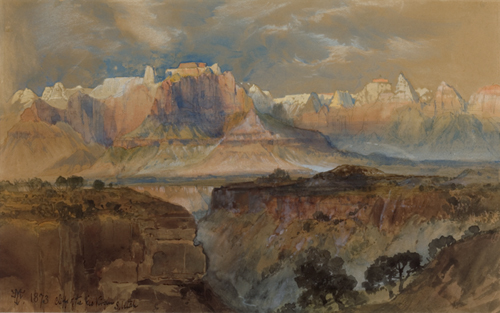
Thomas Moran (American, 1837-1926), Cliffs of the Rio Virgin, South Utah. U.S.A., 1873. Brush and watercolor, white gouache on light-brown wove paper. Gift of Thomas Moran, 1917-17-20. Photo: Matt Flynn
Born in Boston, Winslow Homer is now considered to be one of 19th-century America's greatest artists. For the most part, Homer was self-taught. He began his career as an illustrator working for Harper's Weekly. The etchings he created for Harper's Weekly contain most of the now-hallmark characteristics of his mature style: clean, simple shapes and outlines; sharp contrasts of light and shadow; and animated figures. During the Civil War, he travelled to the Virginia front and painted his first oil of note, 'Prisoners from the Front' (1866). His early experience as an illustrator, his role as a witness of the war and his own interest in nature contributed to Homer's beneficent vision of rural life.
Homer's editors at Harper's Weekly sent him to New Hampshire's White Mountains. Earlier in the century, works by writer Nathaniel Hawthorne and Church's teacher, Cole, had popularised the area. As the number of visitors grew, Homer was there to chronicle what they saw. The Cooper-Hewitt show includes a study for the oil 'Artists Sketching in the White Mountains' (1868), and Homer's 'White Mountain Wagon' (1869 - brush and oil paint on mahogany panel). In this piece, Homer showed how visitors would travel up the mountain. A White Mountain wagon had larger back wheels to support the weight from the front during the trip uphill, and benches with a shade to protect passengers from the sun.
Later, after a stay in an English fishing village between 1881 and 1882, Homer turned his attention almost exclusively to scenes of the sea, fishermen and the inhabitants of fishing villages. He moved to Prout's Neck on the coast of Maine, where he found a new source of inspiration for his work, the struggle between man and the forces of nature.
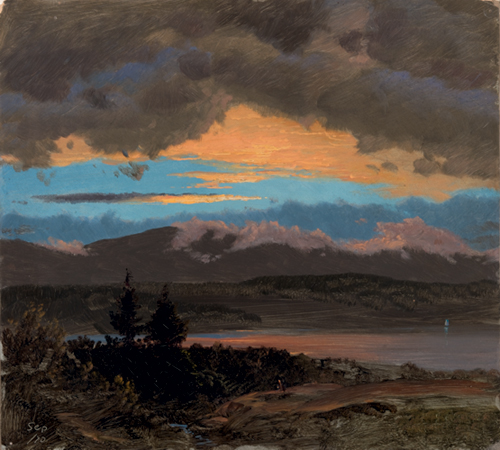
Frederic Edwin Church (American, 1826-1900), Sunset across the Hudson Valley, New York. U.S.A., 1870. Brush and oil paint, graphite on thin cream color paperboard. Gift of Louis P. Church, 1917-4-582-c. Photo: Matt Flynn
Like the members of their audience, Church, Homer and Moran believed in the spirit of adventure - a defining feature of the American character - and wanted to discover America for themselves. But while Church's and Moran's works reveal a near mystical yearning for nature as a bridge to the sublime, Homer's work, equally idealised, is rooted in his appreciation of traditional trades, rural lifestyles and childhood play. In such works as 'Shepherdess Resting' (1877 - charcoal on heavy white wove paper) and 'Young Woman Carrying a Basket' (1879 - graphite on heavy off-white wove paper), he captured the daily rhythms of country life. Childlike innocence is a recurring theme in Homer's work, and one that appealed to a mass audience. His 1872 composition, 'Snap the Whip', became a frequently reproduced image that took on symbolic dimensions and was exhibited at the 1876 Centennial Exposition in Philadelphia. The Cooper-Hewitt show includes a chalk study of the scene showing a lively group of boys playing in a farmyard, as well as Edward La Garde's wood engraving. The oil is in the collection of the Metropolitan Museum of Art.
Homer's interests extended into the decorative arts; in 1877, along with associates including William Merritt Chase and Edward Austin Abbey, Homer formed the Tile Club. Each month, members of the club met to create tiles for fireplace surrounds, furniture inlays, plaques and wall decorations. Visitors to the show will see a fireplace surround, 'The Shepherd and the Shepherdess', made by Homer in 1878. Although the club existed for a decade, Homer's membership was brief; the surround on view is one of a few painted and glazed tile compositions that he worked on. With this and many of his other works, Homer reflected a growing consensus that embraced the past over modern progress.
More so than any other area of the country, the American West and its conquest came to symbolise cherished ideals of adventure, enterprise and can-do spirit. The US government sent geological survey teams to map out the western territories, while those in the rest of the country constructed their views of the West from legends, tall tales and popular accounts in newspapers. Moran's travels with geological teams and the images that he produced found their way into public consciousness through a variety of media. His works - some painted on location, but others done in his studio from studies and memory - were taken for journalistic accuracy.
Born in 1837 in Lancashire, England, Thomas Moran moved with his family to America in 1844. His father, a weaver, brought the family to Philadelphia, a thriving centre for textile arts. As a teen, Moran worked for an engraver. While his engravings were not considered to be accomplished, Moran's drawings were applauded by his employer. Soon after, Moran began to sell watercolours and drawings to admirers in town. Eventually, he and his brother, also an artist, took a studio in Philadelphia and began to develop their individual styles. Thomas studied the works of British painter JMW Turner, to whom his style owes a great debt. Moran's took his first journey in 1860, traveling to Lake Superior where, apparently, no other artists had gone before. Continued travels in America and to England followed.
The first transcontinental railroad was completed in 1869 and marked an explosion of interest in the West. All of the popular periodicals of the day filled their pages with accounts of western travellers. In 1870, Scribner's sent Moran to Yellowstone to illustrate a story by Nathaniel P Langford, 'The Wonders of the Yellowstone', an account of the Washburn-Doane expedition. Moran was enchanted by the West and determined to return. He got his chance in winter 1871, when the government subsidised a survey by FV Hayden and included Moran on the team. He produced a number of watercolours, and his oil, 'The Grand Canyon of the Yellowstone' (1872) made him famous. The government purchased the painting, displayed it in the Capitol Building, and established Yellowstone as the first national park. Public praise led admirers to dub the artist Thomas 'Yellowstone' Moran.
The pieces on view at the Cooper-Hewitt reveal Moran's spiritual connection to the West. The grandeur of America's natural wonders captured his imagination and filled him with a sense of purpose. Such breathtaking views as 'Cliffs of the Rio Virgin, South Utah' (1873 - watercolour); 'Green River, Wyoming' (1879 -gouache) and 'Toltec Gorge, Colorado' (1881 - brush and black, brown and blue ink washes with white gouache) demonstrate his commitment to representing the region's nobility in a variety of media. Best known for a handful of dramatic, large-scale canvases, Moran was a prolific artist who produced more than 1,500 oil paintings, 800 watercolours and numerous drawings from his travels to Lake Superior, Yosemite, the Sierras, Mexico and his summer home in East Hampton, Long Island.
After viewing the glorious works displayed in the beautiful mansion that is home to the Cooper-Hewitt, visitors will, most likely, remain for a while in a blissful reverie, a state that the artists no doubt intended their idylls to produce. Upon further reflection, they may begin to see connections between the rapid and fascinating growth of the infant tourist industry during the second half of the 19th century and the intricate machinery of 21st-century tourism. Powerful images and symbols - the language of myth - given visual articulation by Church, Homer and Moran remain with us today, as Americans continue to search for respite from the frenzy of the modern world. Their yearning is our yearning, and their works to continue to proclaim America's natural wonders. 'Frederic Church, Winslow Homer, and Thomas Moran: Tourism and the American Landscape' opened on 19 May 2006 and runs through 22 October 2006. The exhibition is accompanied by a full-colour, 192-page hardcover catalogue published by Bulfinch Press.
Reference
1. Developed in the 1830s, stereograph technology involves a double image of one subject that is viewed through a stereoscope. To create a stereograph, a single camera is fitted with two lenses, which are placed about the same distance apart as that between the eyes. Once the stereograph is made, a viewer places it in a holder on the stereoscope and looks through two lenses, moving the holder back and forth until the picture comes into focus as a three-dimensional image.